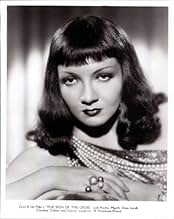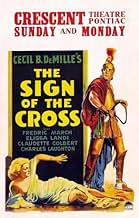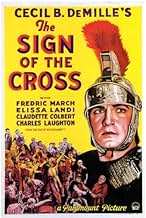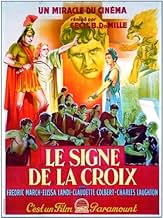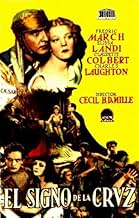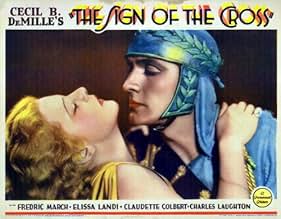VALUTAZIONE IMDb
6,8/10
2904
LA TUA VALUTAZIONE
Aggiungi una trama nella tua linguaA Roman soldier becomes torn between his love for a Christian woman and his loyalty to Emperor Nero.A Roman soldier becomes torn between his love for a Christian woman and his loyalty to Emperor Nero.A Roman soldier becomes torn between his love for a Christian woman and his loyalty to Emperor Nero.
- Regia
- Sceneggiatura
- Star
- Candidato a 1 Oscar
- 3 vittorie e 1 candidatura in totale
Joyzelle Joyner
- Ancaria
- (as Joyzelle)
Robert Seiter
- Philodemus
- (as Robert Manning)
Recensioni in evidenza
Cecil B. DeMille was famous for the excesses he depicted on screen, and "The Sign of the Cross" has enough excess for a dozen movies by any other director. Fortunately, DeMille loved to detail the debauchery that warranted divine punishment, because he was more adept and entertaining when portraying orgies than he was when depicting piety. Perhaps sin is intrinsically more interesting than virtue. Certainly the sinful characters, especially Charles Laughton as Nero and Claudette Colbert as Poppaea, are riveting and colorfully conceived. Laughton lolls around on his divans, while alluring slave boys attend to his whims. Colbert lures and tempts lovers when not catering to her bare flesh in a milk bath. Bloody gladiatorial games and the obligatory feeding Christians to the wild beasts keep the proceedings on track, and an erotic Lesbian dance enlivens an otherwise dragging orgiastic gathering. Orgies can be difficult to film because the delights are far more evident to participants than they are to viewers. Perhaps every orgy needs a Lesbian dance.
Unfortunately, DeMille felt compelled to throw away screen time on a group of early Christians, whose idea of a good time was to sit on rocks, sing tuneless songs, and listen to a motivational speaker. Naturally, the improbably named Marcus Superbus, played by Frederic March in a fetching mini-skirt and tight curls, falls in love with Mercia, a bland, but virginal, Elissa Landi, and he rejects the advances of the milky, silky Claudette Colbert, who had been around the Colosseum a few times. Of course, March not only rejects Colbert, but risks losing the endless parties and his own rising career for the touch of Landi's soft hand. "The Sign of the Cross" is hardly convincing drama despite the lure of Romans sinning every way, everywhere, and with everybody.
If the corny dialog and stilted scenes of pious proceedings had been severely cut and Laughton's and Colbert's roles had been brought to center focus, the film would have been a delicious camp spectacle. However, as the film now plays, viewers must patiently wait out the dull-as-drying-paint scenes with Landi and company to savor the sinful delights of Nero and Poppaea, which make "The Sign of the Cross" worth a look and a hoot or two.
Unfortunately, DeMille felt compelled to throw away screen time on a group of early Christians, whose idea of a good time was to sit on rocks, sing tuneless songs, and listen to a motivational speaker. Naturally, the improbably named Marcus Superbus, played by Frederic March in a fetching mini-skirt and tight curls, falls in love with Mercia, a bland, but virginal, Elissa Landi, and he rejects the advances of the milky, silky Claudette Colbert, who had been around the Colosseum a few times. Of course, March not only rejects Colbert, but risks losing the endless parties and his own rising career for the touch of Landi's soft hand. "The Sign of the Cross" is hardly convincing drama despite the lure of Romans sinning every way, everywhere, and with everybody.
If the corny dialog and stilted scenes of pious proceedings had been severely cut and Laughton's and Colbert's roles had been brought to center focus, the film would have been a delicious camp spectacle. However, as the film now plays, viewers must patiently wait out the dull-as-drying-paint scenes with Landi and company to savor the sinful delights of Nero and Poppaea, which make "The Sign of the Cross" worth a look and a hoot or two.
Hollywood legend has it that DeMille cast Claudette Colbert as Poppaea by asking her if she'd like to play the "wickedest woman in the world". Who could refuse an offer like that? There are already quite a few excellent (and fun) reviews in this column now, but in view of the DVD release I'd like to add a few things. This lavish picture shows DeMille at his best, worst, most decadent and most unusual. I first saw the expurgated World War II era re-release on TV ages ago, and wasn't much impressed. My father said they'd bowdlerized it a lot, so I was curious to see the 1932 original when it appeared on VHS a few years back. "Astound Me" Diaghilev once famously said to Cocteau; and astounded I was. I was expecting a lot more craziness, but I wasn't expecting to see elephants stepping on men's heads or naked women being eaten by crocodiles. Released in December 1932 it is marginally a pre-code movie, but surely only DeMille could have gotten away with it. This movie has nothing to do with Hollywood of the Thirties; this is Hollywood of the Twenties having one last outrageous fling, with all its sex, drugs, decadence, and all round insanity. The movie plays very much like a silent; perhaps it should have been a silent, thus sparing us its greatest defect, which is some of the worst dialog ever perpetrated. Fredric March as Marcus, the male lead, struggles manfully with awful lines throughout; but it is the visual aspect which dominates one's attention. Consider Colbert's legendary bath in a veritable swimming pool filled with milk (and she's really naked under all that milk). A friend, played by Vivian Tobin with kittenish glee, arrives; they exchange a few verbal barbs worthy of a pair of snarky teenagers, then Poppaea simply says "Take off your clothes. Get in here and tell me all about it." Anyone who thinks the naughty implications of this were inadvertent in innocent old 1932 hasn't spent much time in Hollywood Babylon, to say nothing of Hollywood Rome. Colbert is a delight throughout; her scenes with Fredric March play as high comedy. As he desperately tries to assert his nobility and self control, Colbert effortlessly demolishes his dignity with the perfect lazy grace of a leopardess. And let's not forget Charles Laughton, whose Nero is a masterpiece of omnisexual megalomania. Only Peter Ustinov in the 1951 "Quo Vadis" could better him.
This is on the surface a standard lions vs. Christians epic, but it ain't one to take your Sunday School class to. Under no circumstances should this be viewed by kids, even today. Much of the imagery is equivocal, to put it politely, especially during the big arena show that fills the last half hour. And then there's Marcus' big party, where Joyzelle Joyner performs a dance that is startlingly obscene for 1932.
All of this is ravishingly photographed by cameraman Karl Struss, one of the great artists of monochrome, who makes every shot a work of art. There is one scene in the house occupied by Mercia and her aged guardian, where the old man is seen in a hallway with a gate and small yard beyond; in the yard is an urn. The whole shot is lit by a single brilliant light blasting down on the urn, with bounce boards sending the light gently into the house. This violates all the rules of how to light a scene, but the effect is magical. A quick word should also be put in for Rudolph Kopp, who supplied the music (curiously uncredited); he actually has a go at recreating an authentic ancient Roman sound (no actual ancient Roman music survives).
But the core of the picture is the last part, the ultimate Roman circus. DeMille does something genuinely startling here. First he invites us, a little salaciously, to watch the spectacle, which begins with gladiatorial combat, but proceeds to darker and darker exhibits, many of which are genuinely disturbing (I wasn't kidding about the naked women and the crocodiles; wait until you see the Gaulish Amazon women vs. the Pygmies). As it gets more and more evil, we keep cutting to vivid closeups of the audience that we have been invited to join; some excited, some revolted, some merciless, some bored to distraction, some filled with pity, some sadistic, some almost drooling with voyeurism; they are us, and we are them. DeMille has had the effrontery to show us our own faces as we feast our eyes on all this exquisitely photographed mayhem. It's not easy to watch, and I know of nothing else quite like it prior to Stanley Kubrick.
This is on the surface a standard lions vs. Christians epic, but it ain't one to take your Sunday School class to. Under no circumstances should this be viewed by kids, even today. Much of the imagery is equivocal, to put it politely, especially during the big arena show that fills the last half hour. And then there's Marcus' big party, where Joyzelle Joyner performs a dance that is startlingly obscene for 1932.
All of this is ravishingly photographed by cameraman Karl Struss, one of the great artists of monochrome, who makes every shot a work of art. There is one scene in the house occupied by Mercia and her aged guardian, where the old man is seen in a hallway with a gate and small yard beyond; in the yard is an urn. The whole shot is lit by a single brilliant light blasting down on the urn, with bounce boards sending the light gently into the house. This violates all the rules of how to light a scene, but the effect is magical. A quick word should also be put in for Rudolph Kopp, who supplied the music (curiously uncredited); he actually has a go at recreating an authentic ancient Roman sound (no actual ancient Roman music survives).
But the core of the picture is the last part, the ultimate Roman circus. DeMille does something genuinely startling here. First he invites us, a little salaciously, to watch the spectacle, which begins with gladiatorial combat, but proceeds to darker and darker exhibits, many of which are genuinely disturbing (I wasn't kidding about the naked women and the crocodiles; wait until you see the Gaulish Amazon women vs. the Pygmies). As it gets more and more evil, we keep cutting to vivid closeups of the audience that we have been invited to join; some excited, some revolted, some merciless, some bored to distraction, some filled with pity, some sadistic, some almost drooling with voyeurism; they are us, and we are them. DeMille has had the effrontery to show us our own faces as we feast our eyes on all this exquisitely photographed mayhem. It's not easy to watch, and I know of nothing else quite like it prior to Stanley Kubrick.
Yikes! De Mille's erotic raunchy graphic and splendid SIGN OF THE CROSS made at Paramount in 1932, and his first talkie bible study is a movie you not forget. It is infamous and famous for many sights and other comments here will give you the reaction to the graphic cruelty of the truly shocking Arena/Gladiator scenes. The ridiculously entertaining asses milk bath with nipples ahoy and Claudette's milky breasts, the very funny dialog of daily life amid the splendor, the horror of the rape and torture of a teenage Christian boy, the eerie similarity to the 1932 German persecution of the European Jews, the depression era parable of the idle rich uncaring at the financial death of the 1930s masses, the dazzling costumes (no bras in Rome either), the claustrophobic street sets with rushing horses and fights in corners, all in all create an amazing action tableau like a pencil sketch bible book drawing brought to life. The film's art direction and set design and costumes are especially evocative of 'a silent epic with sound' and one easily can transfer the idea of seeing the 1925 BEN HUR with sound as SIGN OF THE CROSS favorably compares. The Arena montage scenes are really shocking. The Moon Dance is outrageous lesbian swankiness and gorgeous as all hell... well pagan hell as depicted by the morally austere Demille. Great moving wallpaper for your next party if played on a big TV and without sound with your CD collection going instead. If you agree that SIGN OF THE CROSS made in 1932 is really a 1920s silent film with dialog, have a look at FOLLOW THRU made two years earlier in 1929 and in color and as jazz modern today in it's creative style. CROSS plays like an ancient movie but FOLLOW THRU still plays new.
1932 – the height of the depression, Paramount studios in financial straits, Hollywood's output limited to small-scale dramas and bedroom comedies – and Cecil B. DeMille decides to make an epic. There are many classics among the "small" pictures of the early-30s, but it's good to see that someone was, against all odds, still carrying the torch for grandeur and spectacle.
Of course, Sign of the Cross is still an epic of its poverty-stricken time. There are no stupendous sets or masses of extras, but DeMille always knew how to make our eyes deceive us. A huddle of a dozen people filling the screen looks like a crowd. Five men on horseback shot from a low angle looks like a stampede. In the scene where Titus and Favius first meet, the camera wheels round and backs away at the same time, giving the impression that the street scene is much more than a cramped indoor set. And DeMille's use of lighting (here courtesy of Karl Struss who was Oscar-nominated for his efforts) really pays off, with fuzzy half-light and shadows disguising the lack of lavishness.
Better yet, the constrained budget seems to have pushed DeMille to concentrating more on the poetry and beauty of what we see. Unable to dazzle us with scale or special effects, he makes full use of his talent for flowing, dreamlike imagery. Sign of the Cross features some of the smoothest camera-work and carefully choreographed movement of extras of this period. He even makes effective use of slow-motion with the pouring goats milk. DeMille was not the only director to turn to simple camera trickery when money was tight – Rouben Mamoulian's earliest pictures for example are end-to-end cheap tricks. It's just that DeMille is doing it better than almost everyone else – it adds sparkle to the picture without being distracting.
But it's not just with the images that DeMille shows his talent. Unlike some directors who were sceptical about the coming of sound and tried to work around it, or some producers who naively thought it automatically made pictures twice as good, DeMille really explores the possibilities of sound. In an early scene, we cut to a close-up Elissa Landi while we hear from off-screen the calls of Romans searching for Christians. We see her reaction to the calls, and this is something that could not be achieved so succinctly in a silent movie. A more obvious example is the torture scene, where we hear the boy's screams, while the camera is pointed elsewhere. The point is, we do not need to see him being tortured because the scream alone has enough impact. However what we do see – the eagle of Rome, a sentry unconcernedly marching back and forth, a flaming torch – adds layers of meaning to the scene.
Of course, this being DeMille, and it being the "pre-code" era, he also seeks to dazzle us with a bit of bare flesh and other assorted depravities. It's one of the great ironies of DeMille's work that his pictures often revel in the very "immorality" they seek to preach against. So the poster advertising the attractions at the Colloseum is as much to whet the appetite of the real-world audience as to show the barbaric tastes of the Roman one. DeMille spends ten minutes of screen time (not to mention more precious money on tin-hat manufacture and zoo rental fees) on the promised blood-fest, which can only be for our entertainment since it is inconsequential to the plot. And, in another bit of audio/visual juxtaposition, while the martyrs' chanting drowns out the "Naked Moon" song, it is the notorious Lesbian dance that DeMille shows us, not the Christians outside.
The acting in Sign of the Cross is a bit of a mixed bag, although it is of a higher standard than many of the DeMille talkies. Charles Laughton is hammily brilliant, laying down a blueprint for Emperor Nero which Peter Ustinov would follow to a well-deserved Oscar-nomination in Quo Vadis (1951). However Laughton's part is fairly small, and the screenplay makes Claudette Colbert the real villain. Colbert is fantastic, playing the Empress as an ancient world vamp, giving by far the best performance of the bunch. It's almost a shame that It Happened One Night re-invented her as a major romantic lead, because she really was at her best when she played villains.
The weakest link in Sign of the Cross, as with many DeMille pictures, is the screenplay. However DeMille's inventiveness, careful construction and strong imagery, not to mention the fact that his pictures are great fun if you don't take them too seriously, transcend the limpness of the script. It was perhaps because DeMille refused to allow his style to be compromised by a limited budget that makes many of his 1930s pictures among his greatest.
Of course, Sign of the Cross is still an epic of its poverty-stricken time. There are no stupendous sets or masses of extras, but DeMille always knew how to make our eyes deceive us. A huddle of a dozen people filling the screen looks like a crowd. Five men on horseback shot from a low angle looks like a stampede. In the scene where Titus and Favius first meet, the camera wheels round and backs away at the same time, giving the impression that the street scene is much more than a cramped indoor set. And DeMille's use of lighting (here courtesy of Karl Struss who was Oscar-nominated for his efforts) really pays off, with fuzzy half-light and shadows disguising the lack of lavishness.
Better yet, the constrained budget seems to have pushed DeMille to concentrating more on the poetry and beauty of what we see. Unable to dazzle us with scale or special effects, he makes full use of his talent for flowing, dreamlike imagery. Sign of the Cross features some of the smoothest camera-work and carefully choreographed movement of extras of this period. He even makes effective use of slow-motion with the pouring goats milk. DeMille was not the only director to turn to simple camera trickery when money was tight – Rouben Mamoulian's earliest pictures for example are end-to-end cheap tricks. It's just that DeMille is doing it better than almost everyone else – it adds sparkle to the picture without being distracting.
But it's not just with the images that DeMille shows his talent. Unlike some directors who were sceptical about the coming of sound and tried to work around it, or some producers who naively thought it automatically made pictures twice as good, DeMille really explores the possibilities of sound. In an early scene, we cut to a close-up Elissa Landi while we hear from off-screen the calls of Romans searching for Christians. We see her reaction to the calls, and this is something that could not be achieved so succinctly in a silent movie. A more obvious example is the torture scene, where we hear the boy's screams, while the camera is pointed elsewhere. The point is, we do not need to see him being tortured because the scream alone has enough impact. However what we do see – the eagle of Rome, a sentry unconcernedly marching back and forth, a flaming torch – adds layers of meaning to the scene.
Of course, this being DeMille, and it being the "pre-code" era, he also seeks to dazzle us with a bit of bare flesh and other assorted depravities. It's one of the great ironies of DeMille's work that his pictures often revel in the very "immorality" they seek to preach against. So the poster advertising the attractions at the Colloseum is as much to whet the appetite of the real-world audience as to show the barbaric tastes of the Roman one. DeMille spends ten minutes of screen time (not to mention more precious money on tin-hat manufacture and zoo rental fees) on the promised blood-fest, which can only be for our entertainment since it is inconsequential to the plot. And, in another bit of audio/visual juxtaposition, while the martyrs' chanting drowns out the "Naked Moon" song, it is the notorious Lesbian dance that DeMille shows us, not the Christians outside.
The acting in Sign of the Cross is a bit of a mixed bag, although it is of a higher standard than many of the DeMille talkies. Charles Laughton is hammily brilliant, laying down a blueprint for Emperor Nero which Peter Ustinov would follow to a well-deserved Oscar-nomination in Quo Vadis (1951). However Laughton's part is fairly small, and the screenplay makes Claudette Colbert the real villain. Colbert is fantastic, playing the Empress as an ancient world vamp, giving by far the best performance of the bunch. It's almost a shame that It Happened One Night re-invented her as a major romantic lead, because she really was at her best when she played villains.
The weakest link in Sign of the Cross, as with many DeMille pictures, is the screenplay. However DeMille's inventiveness, careful construction and strong imagery, not to mention the fact that his pictures are great fun if you don't take them too seriously, transcend the limpness of the script. It was perhaps because DeMille refused to allow his style to be compromised by a limited budget that makes many of his 1930s pictures among his greatest.
Great old DeMille flick about the persecution of Christians in ancient Rome. The movie starts with Emperor Nero (Charles Laughton) laughing and playing music while Rome burns. When someone reminds him that the people might hold Nero responsible, he quickly decides to blame the unpopular believers of the new Christian religion. As Christians are being rounded up and killed, Roman prefect Marcus (Fredric March) falls in love with a Christian girl (Elissa Landi). This doesn't sit well with Empress Poppaea (Claudette Colbert), who's in love with Marcus, and she conspires to have the girl arrested.
Charles Laughton gives an outrageously hammy performance and I loved every second of it. I wish he had been in the film a lot more. Fredric March is good, as always. Lovely Elissa Landi does an admirable job in probably her biggest role but she's eclipsed by Claudette Colbert. What this film is perhaps most famous for is the scene where Colbert takes a bath in donkey milk, in which we see quite a bit of what God gave Ms. Colbert to work with. She's a beautiful woman and it's a very sexy scene. The sets and costumes are great, as one expects from a Cecil B. DeMille picture. It's just a really good film, entertaining and dramatic, with some provocative bits of sex and violence that will surely please pre-Code fans. If for no other reason, see it for Colbert.
Charles Laughton gives an outrageously hammy performance and I loved every second of it. I wish he had been in the film a lot more. Fredric March is good, as always. Lovely Elissa Landi does an admirable job in probably her biggest role but she's eclipsed by Claudette Colbert. What this film is perhaps most famous for is the scene where Colbert takes a bath in donkey milk, in which we see quite a bit of what God gave Ms. Colbert to work with. She's a beautiful woman and it's a very sexy scene. The sets and costumes are great, as one expects from a Cecil B. DeMille picture. It's just a really good film, entertaining and dramatic, with some provocative bits of sex and violence that will surely please pre-Code fans. If for no other reason, see it for Colbert.
Lo sapevi?
- QuizCecil B. DeMille was pressured to drop Ancaria's seductive dance in the orgy scene by Will H. Hays of the Hays Office, but DeMille adamantly refused. Still, censors often cut out gruesome parts of the film, particularly, the cart carrying dead bodies out of the arena, a gorilla dancing around a semi-nude girl, elephants stomping Christians and picking them up with their tusks, crocodiles about to eat a bound girl, etc. These scenes are all in the restored version.
- BlooperWe see a woman tied up in the Coliseum as crocodiles are set loose on her. They are clearly alligators (broad snout), which were unknown to Europeans until Columbus's time, 15 centuries later. Only two countries have alligators: The United States and China.The Romans never went to either place.
- Versioni alternativeRe-released in 1944, with some cuts (sex and sadism scenes) and preceded by a nine minute prologue, set in present time with a WWII theme. This re-release version runs 118 minutes.
- ConnessioniEdited into Through the Centuries (1933)
- Colonne sonoreChristian Hymn No.1
(1932) (uncredited)
Music and Lyrics by Rudolph G. Kopp
Sung a cappella by Christians at the meeting
Reprised by them after their capture and at the arena
Sung a cappella by Elissa Landi and Tommy Conlon
Played and sung offscreen at the end
I più visti
Accedi per valutare e creare un elenco di titoli salvati per ottenere consigli personalizzati
- How long is The Sign of the Cross?Powered by Alexa
Dettagli
Botteghino
- Lordo Stati Uniti e Canada
- 5.971.004 USD
- Tempo di esecuzione2 ore 5 minuti
- Colore
- Proporzioni
- 1.37 : 1
Contribuisci a questa pagina
Suggerisci una modifica o aggiungi i contenuti mancanti


